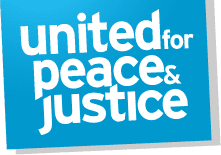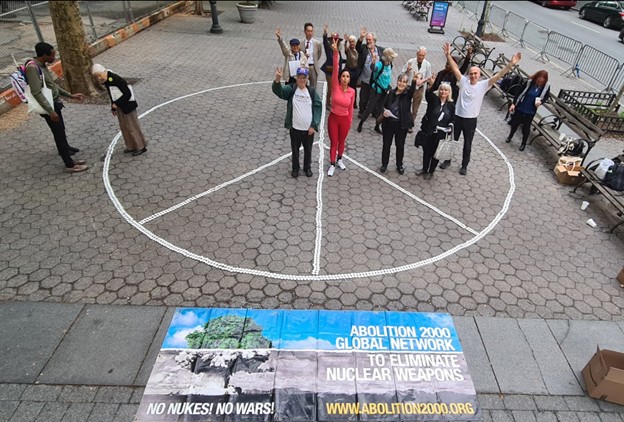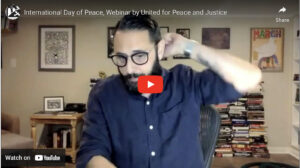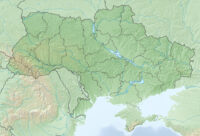Photo credit: Alyn Ware
From April 28 – May 9, 2025, states parties to the Nuclear Nonproliferation Treaty (NPT) met at United Nations headquarters in New York City for the third Preparatory Committee (PrepCom) meeting for the 2026 NPT Review Conference. The NPT represents the only binding commitment to the goal of disarmament by the five original nuclear-armed States – the U.S., UK, USSR/Russia, France, and China. In Article VI, all States pledged “to pursue negotiations in good faith on effective measures relating to cessation of the nuclear arms race at an early date and to nuclear disarmament.” All NPT members aside from the five acknowledged nuclear-armed states are obligated not to acquire nuclear weapons. The NPT entered into force in 1970. In 1995, it was extended indefinitely, with a Review Conference to be held every five years, and PrepComs to be held in between. Every country in the world is a party to the NPT with five exceptions: India, Israel, Pakistan, and North Korea (all nuclear-armed), and South Sudan.
While the nuclear-armed states continued to give lip-service to the “ultimate” goal of elimination, their failure to demonstrate good faith progress on implementation of the disarmament obligation, and the Russian Federation’s repeated nuclear threats in its war on Ukraine hung over the conference like a dark cloud.
As Ambassador Alexander Kmentt of Austria, a global leader on nuclear disarmament, declared in his opening statement: “We meet at a profoundly concerning juncture for the international community and for international peace and security. Beyond the many well-known and growing challenges in the nuclear field and to the NPT, the very principle of multilateralism is increasingly at stake. International law and the UN Charter face unprecedented strain. The most egregious breach is Russia’s illegal invasion of Ukraine, marked by countless violations of international humanitarian law (IHL) and unacceptable nuclear threats. Elsewhere, international law, IHL and human rights are also disregarded, while some actors appear to question and challenge the UN system as a whole…..
We are approaching this Preparatory Committee and next year’s Review Conference very much with this in mind. First, we must safeguard the multilateral disarmament and non-proliferation regime and the NPT in particular. Nuclear weapons remain as one of the most pressing global and truly existential threats facing the entire international community and only multilateral cooperation grounded in international law can address them. Secondly, a business as usual approach to the NPT is insufficient. Nuclear risks are too high and so are the risks for the NPT regime. We must spare no effort to address these challenges, push for the full implementation of the Treaty and preserve its integrity. Geopolitical tensions cannot be an excuse for inaction, they make progress all the more imperative…..
All nuclear weapon states bear a particular duty and responsibility toward the entire international community to reduce and eliminate nuclear risks and to avoid any actions that exacerbate nuclear risks. The obvious gold standard of nuclear risk reduction is the elimination of nuclear weapons.”
For the most part, government representatives restated their well-trodden positions – the non-nuclear states decrying the lack of progress on disarmament and the nuclear-armed states claiming that “conditions” are not ripe for disarmament. Other frequently stated concerns were the treaty’s lack of universality, and fears of proliferation of nuclear weapons to additional countries. But the one thing almost all countries agreed on – even while recognizing the dangers of nuclear power plants being weaponized for the first time by the Russian Federation in Ukraine, and the realities of nuclear disasters like Fukushima – was the over-the-top promotion of “peaceful” nuclear technology as the solution to most of humanity’s problems. Article IV of the NPT guarantees the “inalienable right of all the Parties to the Treaty to develop research, production and use of nuclear energy for peaceful purposes without discrimination.” Elevating and enhancing this provision is particularly dangerous at a time when a nuclear “renaissance’ is being disingenuously promoted as a solution to climate change.
While the tone of the proceedings was mostly civil, it was marked by occasional outbursts and disruptions, such as when the representative of the Russian Federation called Ukrainian President Zelensky a Nazi and the representatives from the European Union countries walked out. The Trump administration didn’t seem to be paying much attention to this PrepCom; the head of its delegation, a previously unknown State Department lifer, basically restated the positions put forth by his predecessors during the Biden Administration.
In the end, for reasons obscured by a closed door session, the NPT PrepCom was unable to reach agreement on substantive Recommendations for the NPT Review Conference or procedural recommendations for Strengthening the Review Process, agreeing only to the date and venue for next year’s Review Conference (April 27 – May 22, 2026 in New York) and nominating its President (Vietnam).
In contrast, there was a robust civil society presence on the margins of the PrepCom, with many educational side events, and a session of the PrepCom itself dedicated to presentations from civil society organizations. This year there were 21 such presentations, including by Nihon Hidankyo, the association of Hiroshima and Nagasaki A-bomb survivors and recipient of the 2024 Nobel Peace Prize; the Mayors of Hiroshima and Nagasaki; the Fiji Nuclear Victims and Families Association; the International Campaign to Abolish Nuclear Weapons; International Physicians for the Prevention of Nuclear War; Parliamentarians for Nuclear Nonproliferation and Disarmament; Solidarity for Peace and Reunification of Korea; Western States Legal Foundation; and Youth Fusion, the youth network of Abolition 2000.
For a detailed account of the 2025 NPT PrepCom, read Reaching Critical Will’s NPT News in Review.
About Abolition 2000
Following the collapse of the Soviet Union, there was a brief period of optimism about the possibility of nuclear disarmament. The Abolition 2000 Global Network to Eliminate Nuclear Weapons was established at the 1995 NPT Review and Extension Conference with the launch of an appeal to the NPT States Parties (Abolition 2000 Founding Statement) calling on them to “Initiate immediately and conclude negotiations on a nuclear weapons abolition convention that requires the phased elimination of all nuclear weapons within a timebound framework, with provisions for effective verification and enforcement,” and to undertake a number of other practical measures to end the nuclear arms race, prevent nuclear war, and support the global elimination of nuclear weapons. It also recognizes “the inextricable link between the ‘peaceful’ and warlike uses of nuclear technologies and the threat to future generations inherent in creation and use of long-lived radioactive materials.”
At its 1997 meeting in Te Ao Maohi (French Occupied Polynesia), Abolition 2000 adopted a supplement to its Founding Statement. The Moorea Declaration recognizes that “Colonised and indigenous peoples have, in the large part, borne the brunt of this nuclear devastation – from the mining of uranium and the testing of nuclear weapons on indigenous peoples land, to the dumping, storage and transport of plutonium and nuclear wastes, and the theft of land for nuclear infrastructure.”
Some of the calls in the Abolition 2000 Founding Statement have been achieved, such as the 1996 International Court of Justice Advisory Opinion affirming the illegality of the threat or use of nuclear weapons, the establishment of additional nuclear-weapon-free zones, and the establishment of an international energy agency to promote and support the development of sustainable and environmentally safe energy source (IRENA). Others have yet to be realized.
A lot has changed since 1995, but Abolition 2000 is still here and celebrated its 30th anniversary during the 2025 NPT PrepCom.
Abolition 2000 at the 2025 NPT PrepCom: Lighting the Way to Peace!
Abolition 2000 celebrated its 30th anniversary during the NPT PrepCom, with several events. On April 30, Abolition 2000 live-streamed an interview from the UN, with co-founders, Jackie Cabasso and Alyn Ware, who were interviewed remotely by members of Youth Fusion, Camilla Braito and Ayleen Roy. Watch the recording of Abolition 2000 Live From the UN here.
On May 6, Abolition 2000 held an interactive side event, On our 30th Anniversary, Past Lessons; New Realities, inviting civil society observers to the NPT PrepCom to reflect on the large shifts in global politics, including
the abrupt and long-term changes brought on by the Trump administration and their effects on nuclear weapons policies; Russia’s nuclear sharing with Belarus; recent open discussion of an independent European nuclear force backed by French and UK nuclear weapons; and the potential for new nuclear states in Northeast Asia.
To celebrate its 30th birthday, Abolition 2000 held a 30th Anniversary Celebration: Lighting the Way to Peace! on the evening of May 7 – coinciding with the 201st anniversary of Beethoven’s “Ode to Peace” (from his Ninth Symphony). The event took place in Dag Hammarskjöld Plaza, across the street from the UN. It was a joyful, intergenerational celebration honoring the longevity of our movement and engaging local allies and musicians. The centerpiece of the party was an impressive display of 2000 tea candles arranged in the shape of a giant international peace symbol. The Raging Grannies led community singing and birthday cake was shared. The in-person event was accompanied by a social media campaign, 2000 Candles for Abolition, organized by Youth Fusion. Sally Jones of Peace Action New York State shared a wonderful photo album from the event, which you can view here.
The Abolition 2000 network is open to individuals and organizations to join. By the year 2000, over 2000 organizations had joined.
Join Youth Fusion here. Sign up for Youth Fusion’s newsletter here.



